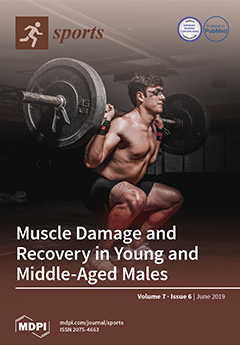This study compared the time course of recovery after a squatting exercise in trained young (YG;
n = 9; age 22.3 ± 1.7 years) and trained (MT;
n = 9; 39.9 ± 6.2 years) and untrained (MU;
n = 9; age 44.4 ±
[...] Read more.
This study compared the time course of recovery after a squatting exercise in trained young (YG;
n = 9; age 22.3 ± 1.7 years) and trained (MT;
n = 9; 39.9 ± 6.2 years) and untrained (MU;
n = 9; age 44.4 ± 6.3 years) middle-aged males. Before and at 24 and 72 h after 10 × 10 squats at 60% one-repetition maximum (1RM), participants provided measurements of perceived muscle soreness (VAS), creatine kinase (CK), maximal voluntary contraction (MVC), voluntary activation (VA), and resting doublet force of the knee extensors and squatting peak power at 20% and 80% 1RM. When compared to the YG males, the MT experienced
likely and
very likely moderate decrements in MVC, resting doublet force, and peak power at 20% and 80% 1RM accompanied by
unclear differences in VAS, CK, and VA after the squatting exercise. MU males, compared to MT, experienced greater alterations in peak power at 20% and 80% 1RM and VAS. Alterations in CK, MVC, VA, and resting doublet force were
unclear at all time-points between the middle-aged groups. Middle-aged males experienced greater symptoms of muscle damage and an impaired recovery profile than young resistance trained males. Moreover, regardless of resistance training experience, middle-aged males are subject to similar symptoms after muscle-damaging lower-body exercise.
Full article






